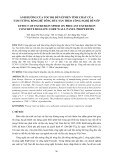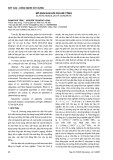
Journal of Science and Transport Technology Vol. 4 No. 1, 13-22
Journal of Science and Transport Technology
Journal homepage: https://jstt.vn/index.php/en
JSTT 2024, 4 (1), 13-22
Published online 22/03/2024
Article info
Type of article:
Original research paper
DOI:
https://doi.org/10.58845/jstt.utt.2
024.en.4.1.13-22
*Corresponding author:
E-mail address:
quangln@utt.edu.vn
Received: 17/02/2024
Revised: 18/03/2024
Accepted: 20/03/2024
Nonlinear dynamic buckling analysis of the
FG-GPLRC cylindrical and sinusoid panels
with porous core under time-dependent axial
compression
Nguyen Thi Phuong1,2, Vu Minh Duc1,2,3, Luu Ngoc Quang4,*
1Laboratory of Advanced Materials and Structures, Institute for Advanced
Study in Technology, Ton Duc Thang University, Ho Chi Minh City, Vietnam,
nguyenthiphuong@tdtu.edu.vn
2Faculty of Civil Engineering, Ton Duc Thang University, Ho Chi Minh City,
Vietnam
3Institute of Transport Technology, University of Transport Technology, Hanoi,
Vietnam
4Faculty of Civil Engineering, University of Transport Technology, Hanoi,
Vietnam
Abstract: The nonlinear dynamic buckling responses of functionally graded
graphene platelet reinforced composite (FG-GPLRC) cylindrical and sinusoid
panels with porous core are presented in this paper. The governing
formulations are established by applying the nonlinear higher-order shear
deformation theory (HSDT). an approximation technique is used to determine
the stress function for complexly curved panels. Euler-Lagrange equations can
be used to achieve the nonlinear motion equation. Numerical investigations are
considered using the Runge-Kutta method for dynamic responses, and using
the Budiansky-Roth criterion for critical dynamic buckling loads. Some
discussions on the dynamic buckling responses of panels with porous core can
be achieved from the numerical examples.
Keywords: Sinusoid panel; Cylindrical panel; Dynamic buckling; Higher-order
shear deformation theory (HSDT); Nonlinear mechanics; Functionally graded
graphene platelet-reinforced composite;
1. Introduction
Cylindrical panels and Rectangular plates
are widely used in many structures in engineering
fields. Therefore, a lot of researchers have posed
different problems for these structures such as
linear and nonlinear dynamic and static buckling
behavior, vibration, and dynamic response
behavior, …
Dynamic responses and vibration of
functionally graded material (FGM) plates with
variable delamination parameters were studied by
Wang et al. [1] using the extended Chebyshev–Ritz
method. Liew et al. [2] investigated the vibration
behavior of coating-FGM-substrate cylindrical
panels subjected to a temperature gradient across
the thickness with general boundary conditions.
The static behavior of viscoelastic FGM cylindrical
panels under uniform pressure was studied by
Norouzi and Alibeigloo [3] using the 3D elasticity
theory, state space method, state space differential
quadrature method, and Fourier expansion. The
semi-analytical approaches for dynamic buckling






























